Sycamore is a name which has been applied to several types of trees, but with somewhat similar leaf forms. The name derives from the ancient Greek συκόμορος (sūkomoros) meaning "fig-mulberry".
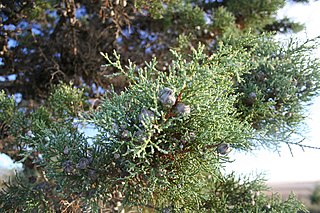
Cypress is a common name for various coniferous trees or shrubs of northern temperate regions that belong to the family Cupressaceae. The word cypress is derived from Old French cipres, which was imported from Latin cypressus, the latinisation of the Greek κυπάρισσος (kyparissos).
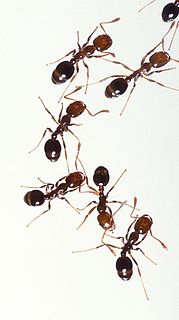
Fire ant is the common name for several species of ants in the genus Solenopsis. They are, however, only a minority in the genus, which includes over 200 species of Solenopsis worldwide. Solenopsis are stinging ants and most of their common names reflect this, for example, ginger ants and tropical fire ants. Many species also are called red ants because of their light brown color, though species of ants in many other genera are similarly named for similar reasons. Examples include Myrmica rubra and Pogonomyrmex barbatus.

Marmots are large squirrels in the genus Marmota, with 15 species.
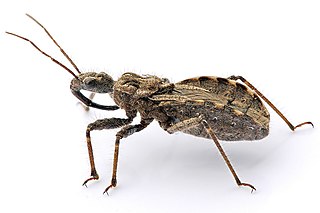
The Reduviidae are a large cosmopolitan family of the order Hemiptera. They can be perceived as slightly unusual, but they are very common among the Hemiptera because almost all are terrestrial ambush predators. The main examples of nonpredatory Reduviidae are some blood-sucking ectoparasites in the subfamily Triatominae. Though spectacular exceptions are known, most members of the family are fairly easily recognizable; they have a relatively narrow neck, sturdy build, and formidable curved proboscis. Large specimens should be handled with caution, if at all, because they sometimes defend themselves with a very painful stab from the proboscis.

The Leptotyphlopidae are a family of snakes found in North America, South America, Africa, & Asia. All are fossorial and adapted to burrowing, feeding on ants and termites. Two subfamilies are recognized.
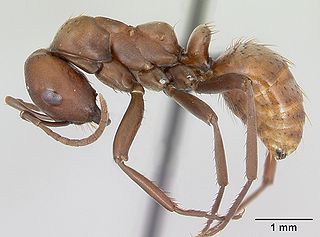
Polyergus, also called Amazon ants, is a small genus of 14 described species of "slave-raiding" ants. Its workers are incapable of caring for brood, in part due to their dagger-like, piercing mandibles, but more importantly, because in the evolution of their parasitism on certain species of the host genus Formica, they have lost the "behavioral wiring" to carry out even rudimentary brood care, or even to feed themselves. Polyergus workers exist in essence as a specialized brood-acquiring caste in their mixed Polyergus/Formica colonies, maintaining the Formica worker force by robbing brood, especially pupae, of particular species in the closely related genus Formica in massive colony-to-colony raids. The captured ants are generally referred to as "slaves" in scientific and popular literature, though recent attempts have been made to apply other human cultural models, such as describing the Polyergus individuals of a colony as "raiders" or "pirates" or "kidnappers" and the Formica workers as "helper-ants", or "domesticated animals". Biologists describe the system as parasitism by "dulosis" (slavemaking) by Polyergus on the host Formica species.

Ophrys insectifera, the fly orchid, is a species of orchid and the type species of the genus Ophrys. It is remarkable as an example of sexually-deceptive pollination and floral mimicry as well as of a highly-selective and highly evolved plant-pollinator relationship.

Pellaea is a genus of ferns in the Cheilanthoideae subfamily of the Pteridaceae. The genus name is derived from the Greek word πελλος (pellos), meaning "dark," and refers to the bluish-gray stems. Members of the genus are commonly known as cliffbrakes. They primarily grow in rocky habitats, including moist rocky canyons, slopes, and bluffs.
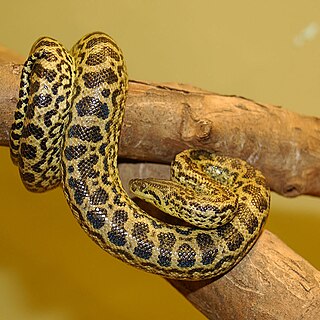
The yellow anaconda, also known as the Paraguayan anaconda is a boa species endemic to southern South America. It is one of the largest snakes in the world but smaller than its close relative, the green anaconda. Like all boas and pythons, it is non-venomous and kills its prey by constriction. No subspecies are currently recognized.
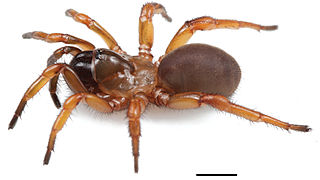
Myrmekiaphila is a genus of trapdoor spiders in the family Euctenizidae. All described species are endemic to the southeastern United States. The genus was transferred from the Ctenizidae by Raven in 1985. M. flavipes was transferred from genus Aptostichus in 2007.
Astreptorhachis is an extinct genus of Late Carboniferous dissorophoid temnospondyl within the family Dissorophidae. It is known only from one species, Astreptorhachis ohioensis, that was collected from Jefferson County, Ohio by the Ohio Geological Survey in 1953 and described by Peter Vaughn in 1971. The holotype and only known specimen consists of a few neural spines and is currently reposited in the Smithsonian Museum of Natural History. The genus name derives from the Greek words astreptos ("inflexible") and rhachis ("backbone"). The specimen was recognized as being similar to the dissorophid Platyhystrix rugosus from the southwestern United States in have greatly elongate neural spines. Astreptorhachis is differentiated from Platyhystrix by the fusion of successive neural spines and the extensively developed tubercles that cover the external surfaces. It is speculated that the elongation of the spines served to stiffen the backbone, being advantageous for terrestrial locomotion, but the purpose of the fusion of successive spines remained unclear in the absence of other material of this taxon.
P. californicus may refer to:
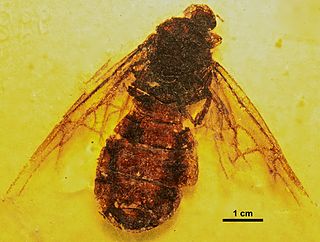
Titanomyrma is a genus of prehistoric giant ant. The latest species to be discovered, T. lubei, was described in 2011, when a 49.5-million-year-old fossilized winged queen ant, comparable in size to hummingbirds, was found in Wyoming, United States. This fossil is the first fossil of a giant ant found in the Western Hemisphere. The presence of Titanomyrma in North America is considered to indicate "the first reported cross-Arctic dispersal by a thermophilic insect group". Another fossil species of this genus, T. gigantea, is the largest-known fossil or extant species of giant ant in the world.
Scapanops is an extinct genus of dissorophid temnospondyl amphibian known from the Early Permian Nocona Formation of north-central Texas, United States. It contains only the type species Scapanops neglecta, which was named by Rainer R. Schoch and Hans-Dieter Sues in 2013. Scapanops differs from other dissorophids in having a very small skull table, which means that its eye sockets are unusually close to the back of the skull. The eye sockets are also very large and spaced far apart. Scapanops was probably small-bodied with a proportionally large head and short trunk and tail. Like other dissorophids, it probably spent most of its life on land.
Formosimyrma is a genus of ants in the subfamily Myrmicinae containing the single species Formosimyrma lanuyensis.

Pilotrochus is a genus of ants in the subfamily Myrmicinae containing the single species Pilotrochus besmerus. It is known from Madagascar.

Dorymyrmex bicolor is a species of ant in the Dolichoderinae subfamily. Dorymyrmex bicolor was recently known as Conomyrma bicolor but has been renamed to Dorymyrmex bicolor. Dorymyrmex bicolor has a single petiole and a slit-like orifice which releases chemical compounds. This ant does not have the capability to sting. Dorymyrmex bicolor is primarily found in arid desert regions in Central and South America and the southwestern United States.
Iridomyrmex longisoma is a species of ant in the genus Iridomyrmex. Described by Heterick and Shattuck in 2011, the ant is endemic to Australia, confined in Western Australia, and nests are known to inhabit into sandy soil.
Iridomyrmex macrops is a species of ant in the genus Iridomyrmex. Described by Heterick and Shattuck in 2011, the species is endemic to several states in Australia.

















